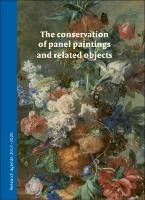The conservation of panel paintings and related objects
Research agenda 2014 -2020
| dc.contributor.author | van Grevenstein, Anne | |
| dc.contributor.author | New, Britta | |
| dc.contributor.author | Young, Christina | |
| dc.contributor.author | Seymour, Kate | |
| dc.contributor.author | Groves, Roger | |
| dc.contributor.author | Horie, Velson | |
| dc.contributor.editor | Kos, Nico | |
| dc.contributor.editor | van Duin, Paul | |
| dc.date.accessioned | 2020-06-09T10:43:53Z | |
| dc.date.available | 2020-06-09T10:43:53Z | |
| dc.date.issued | 2014 | |
| dc.identifier | OCN: 1253408460 | |
| dc.identifier.uri | http://library.oapen.org/handle/20.500.12657/39483 | |
| dc.description.abstract | Until the early 17th century almost all portable paintings were created on wood supports, including masterpieces by famous painters, ranging from Giotto to Dürer to Rembrandt. The structural conservation of these paintings requires specific knowledge and skills as the supports are susceptible to damage caused by unstable environmental conditions. Unfortunately, past structural interventions often caused significant damage due to insufficient knowledge of the behaviour of the wood panels, glue and paint layers. Over the last fifty years, the field has developed treatment strategies based on interdisciplinary collaboration and on the knowledge of specialist conservators. Most current conservation protocols rely on empirical knowledge of conservators and are not necessarily based on a scientific understanding of the nature and behaviour of wood and paint layers. In order to move the field forward, it is imperative to strengthen scientific research into the production methods, ageing and future behaviour of panel paintings, being an intricate interplay between different materials. A deeper understanding of the processes that adversely affect panel paintings over time will contribute to the improved care and conservation of these artworks. The Netherlands Organisation for Scientific Research (NWO) and the Rijksmuseum Amsterdam brought together a group of experts from different disciplines to recommend specific areas in the field that would benefit from systematic research. The experts concluded that targeted interdisciplinary research projects are key to understanding the behaviour of panel paintings and help conservators make better informed decisions. Research into chemical and physical properties of wood, glue and paint layers should be combined with an evaluation of past and current conservation treatments. Research should also consider the history of the object, studio practice, conservation history and thoughts on long-term impact of treatments. | en_US |
| dc.language | English | en_US |
| dc.subject.classification | thema EDItEUR::A The Arts | en_US |
| dc.subject.other | paintings | en_US |
| dc.subject.other | panel paintings | en_US |
| dc.subject.other | conservation | en_US |
| dc.subject.other | wood | en_US |
| dc.title | The conservation of panel paintings and related objects | en_US |
| dc.title.alternative | Research agenda 2014 -2020 | en_US |
| dc.type | book | |
| oapen.relation.isPublishedBy | d630adb8-917c-41f5-b06b-181c7f480248 | en_US |
| oapen.relation.isFundedBy | da087c60-8432-4f58-b2dd-747fc1a60025 | en_US |
| oapen.collection | Dutch Research Council (NWO) | |
| oapen.pages | 226 | en_US |
| oapen.place.publication | The Hague | en_US |
| oapen.grant.program | Science4Arts | |
| oapen.remark.public | 21-7-2020 - No DOI registered in CrossRef for ISBN 97890778775834 |

